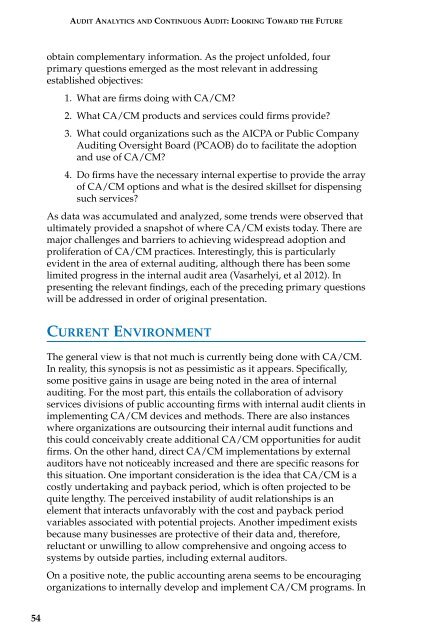AUDIT ANALYTICS AUDIT
1JWn3ix
1JWn3ix
Create successful ePaper yourself
Turn your PDF publications into a flip-book with our unique Google optimized e-Paper software.
<strong>AUDIT</strong> <strong>ANALYTICS</strong> AND CONTINUOUS <strong>AUDIT</strong>:LOOKING TOWARD THE FUTURE<br />
obtain complementary information. As the project unfolded, four<br />
primary questions emerged as the most relevant in addressing<br />
established objectives:<br />
1. What are firms doing with CA/CM?<br />
2. What CA/CM products and services could firms provide?<br />
3. What could organizations such as the AICPA or Public Company<br />
Auditing Oversight Board (PCAOB) do to facilitate the adoption<br />
and use of CA/CM?<br />
4. Do firms have the necessary internal expertise to provide the array<br />
of CA/CM options and what is the desired skillset for dispensing<br />
such services?<br />
As data was accumulated and analyzed, some trends were observed that<br />
ultimately provided a snapshot of where CA/CM exists today. There are<br />
major challenges and barriers to achieving widespread adoption and<br />
proliferation of CA/CM practices. Interestingly, this is particularly<br />
evident in the area of external auditing, although there has been some<br />
limited progress in the internal audit area (Vasarhelyi, et al 2012). In<br />
presenting the relevant findings, each of the preceding primary questions<br />
will be addressed in order of original presentation.<br />
CURRENT ENVIRONMENT<br />
The general view is that not much is currently being done with CA/CM.<br />
In reality, this synopsis is not as pessimistic as it appears. Specifically,<br />
some positive gains in usage are being noted in the area of internal<br />
auditing. For the most part, this entails the collaboration of advisory<br />
services divisions of public accounting firms with internal audit clients in<br />
implementing CA/CM devices and methods. There are also instances<br />
where organizations are outsourcing their internal audit functions and<br />
this could conceivably create additional CA/CM opportunities for audit<br />
firms. On the other hand, direct CA/CM implementations by external<br />
auditors have not noticeably increased and there are specific reasons for<br />
this situation. One important consideration is the idea that CA/CM is a<br />
costly undertaking and payback period, which is often projected to be<br />
quite lengthy. The perceived instability of audit relationships is an<br />
element that interacts unfavorably with the cost and payback period<br />
variables associated with potential projects. Another impediment exists<br />
because many businesses are protective of their data and, therefore,<br />
reluctant or unwilling to allow comprehensive and ongoing access to<br />
systems by outside parties, including external auditors.<br />
On a positive note, the public accounting arena seems to be encouraging<br />
organizations to internally develop and implement CA/CM programs. In<br />
54


